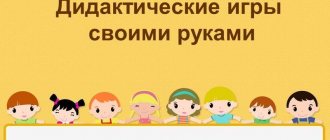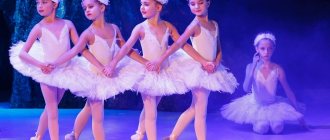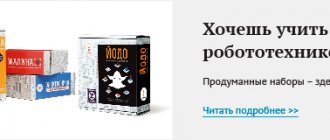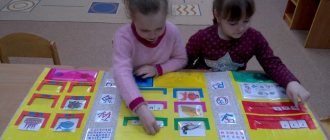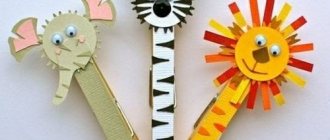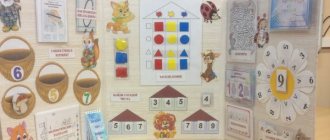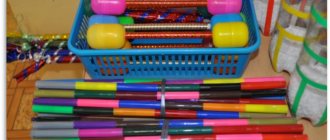Developmental manual “Rings of Lull”
Senior preschool age is a favorable period for the development of logical thinking and creative imagination. Along with educational board and word games, I use elements of a system developed by the philosopher Raymond Lull. The developers of TRIZ adapted his methodology to a preschool institution, and this is how the developmental guide “Rings of Lull” appeared. This manual effectively solves developmental problems, such as the development of logical thinking, imagination, speech, etc.
How to make Llull rings
Making Llull rings is very easy. You will need a rod from an old pyramid and circles of thick cardboard of different diameters. Rings divided into the same number of sectors must be rotated in any direction, creating a variety of combinations.
Method of working with Lull rings
The operating principle is as follows. For example, you introduce preschoolers to animals. On one of the rings there are images of animals, on the second their habitats, on the third the food of animals. By rotating the rings and connecting sectors, preschoolers will remember that a bird lives in a nest and eats insects, and a penguin lives in ice and eats fish.
With age, this game can be complicated; children can be asked to think about what will happen to a squirrel if it gets into the nest and eats carrots (children can connect sectors in any combination and thus make up creative stories).
Lull rings can be used in any area. For example, to consolidate knowledge of numbers and the ability to count objects (on one ring there is a group of objects, on the other there is a corresponding number), knowledge of geometric shapes (connecting an object of a certain shape with a standard), developing phonemic awareness (connecting a picture with a letter indicating the first sound in a word, and on the third ring you can depict a syllable analysis scheme and count the syllables in words). The options for using this guide are endless. Introducing children to the man-made and natural world, I made these Lull rings.
The largest one depicts objects or natural phenomena, on the second circle there is a part of an object, and on the third there are icons - a hand or a place where this phenomenon can be found. By rotating the rings, the children find out that the dress has buttons and is made by human hands, while the wood is created by nature. Options for creative tasks using these rings:
- Is there a bear or an elephant created not by nature, but by man? (figurines, children sculpt animals, maybe a painted elephant, etc.).
- Is it possible to find a kettle with wheels? Try to write a funny story about such a kettle.
> It is advisable to select circles with images of samples of materials - wood, plastic, glass, etc., various pieces of furniture, dishes, household appliances.
A circle with different shades of colors, as well as depicting the location of different objects, will also come in handy. By stringing such circles on a rod and spinning them in any order, you can fantasize for a very long time. For example, figure out why there is a blue fabric phone on the space station. The children's answers will be very unexpected and it is also a very fun activity. The more removable rings are made, the more interesting and varied the developing creative tasks for children can be. I hope the material was useful to you, dear colleagues. Good luck and creative success!
Master class for teachers “Entertaining circles of Lull”
Master class for teachers
"Entertaining Circles of Lull"
Sobkovich Lyubov Anatolevna
Teacher of 1st qualification category
MBDOU "Novoagansky DSKV "Forest Fairy Tale"
Target:
to form teachers’ ideas about the use of the “Rings of Lull” methodology in working on the development of the active vocabulary of preschoolers.
Equipment: k
pictures depicting objects and materials; a large circle on a fabric basis, divided into sectors; cards-schemes; carafe of water; booklets.
Preliminary work:
development of booklets “Methodology of the Rings of Lull”
Progress of the event
1. — Today I want to introduce you to the unique “Ring of Lull” technique. The founder of this method is Raymond Lull. He invented circles on which one could find the answer to any question by simply spinning it. Modern TRIZ authors were very interested in this method and they decided to adapt it to educational activities with preschoolers. Lelyukh Svetlana Viktorovna, Sidorchuk Tatyana Aleksandrovna and Khomenko Nikolai Nikolaevich, based on the Lullism method, developed a methodology for kindergarten - “Lull’s Rings”. The central place in it is occupied by a multifunctional manual - Lull circles.
They come in two types: horizontal and vertical. Teachers can use from 2 to 4 circles depending on the age of the children. The circles are divided into sectors, the number of which varies from 4 to 8. A picture is placed on each sector of the circle. In my practice, I use interchangeable pictures, which allows me to use the same base - a circle - for different games.
The technology for working with speech circles is that the child, unwinding the rings, explains the combination of pictures that fall under the arrow or in the free sector. The versatility of the gaming material lies in the fact that using only a few rings you can get different versions of the game, or an addition to the game being played. Children really like this manual; they are happy to replace the rings on their own, combine tasks, and try to determine the goal and rules of the game themselves.
2. The authors of the “Rings of Lull” method use such a concept as training. This is a series of games united by one theme. The trainings consist of 4 types of tasks :
- Type 1: “Find a real combination.”
Children under the arrow combine pictures that form a real picture of the world. Make up sentences that combine these objects. They draw conclusions. For example, a birch leaf is a green blot. Green birch leaf. Birch leaves are green in summer.)
- Type 2: “Explain the unusual combination.”
When unwinding circles, they consider the random connection of objects and explain the unusualness of their interaction as reliably as possible. For example, a birch leaf is a black blot. The birch leaf may be black at night.)
- Type 3: “Come up with a fantastic story or fairy tale.”
In this case, the combination of random objects serves as the basis for fantasy. It is proposed to compose a fantastic story or fairy tale. Here children can say anything, it is important to accept any child’s answer and not evaluate it from the point of view of “right or wrong.” There are no wrong answers in this game.
- Type 4: “Solve the problem.”
In fantastic fairy tales, different stories happen to the heroes. It is necessary to teach the child to formulate problems and put forward ideas for solving them.
— Dear colleagues, I suggest you lose this option. We got the combination “Glass - suitcase”.
-What item would we receive? (glass suitcase)
— What could be good in a glass suitcase?
— What are the disadvantages of a glass suitcase?
“But the trouble is, the owner of this suitcase was not very happy with this transformation.” He doesn't want everyone to see what's in his suitcase. Help him solve this problem.
Teacher options
— I was interested to hear your options, I hope this task caused positive emotions for you, just like for children who play with circles in kindergarten.
3. Such games can be organized without having a manual at hand. And now we will try to do this. I invite those who received cards from my assistant to come out.
The working material in the game that I have prepared for you will be pictures depicting objects and material.
- Whose cards with the image of the material form an inner circle.
- Whose cards with images of objects form an outer circle.
- What image do we have under the arrow? (………) Our first task will be on “Real Combination”. Our inner circle remains motionless, but the outer circle moves clockwise until an object suitable for this material falls under the arrow.
Teachers complete the task.
- What combination did we get? (…………) Young!
— For the game “Explain the unusual combination,” we will spin two circles. The inner circle moves clockwise, and the outer one moves counterclockwise, until I say the words. Ready?
We walk around each other.
Just don't yawn.
Everything that the arrow shows us
Let's call it together.
—
What combination did we get? (……) Now we will fantasize. Try to explain the unusualness of this combination. When or where might such a combination happen?
- And now we move on to the third type of game “Come up with a fantastic story or fairy tale.” You can start with the well-known words of once upon a time or once upon a time an evil wizard...
One story is heard.
“Usually the children all start telling stories together, and it turns out to be a collective story.”
— Thank you very much, dear colleagues. The fourth task in our game was supposed to be “Solving a Problem,” but we looked at it a little earlier using the example of a glass suitcase.
— Now, I would like to introduce you to another version of the game that appeared in our group while working on the experiment. That's why we have this wonderful multi-colored circle. You see sectors on it, the same as on the Lull circles.
— We need 8 people to play. The rules of the game are simple. Our task is to talk about the object that is in the center of the circle, based on the diagrams located in the sectors of the circle. They are all familiar to you. When I begin to pronounce the words, you will move in a circle, as soon as I finish, you must stop. The object that we will describe today will be water.
In an even circle, one after another
We are going step by step.
Stand still - find a sign
Describe the object in the center.
Teachers describe the object based on their diagram.
- I thank you, colleagues, you can sit down. Such a game can be used in class, as a technique for summing up, and can be used in joint activities during the day. If there are a large number of children in the group, you can ask them to complement the participants’ answers, but not repeat them.
4. – In my master class, I tried to briefly present the main principles of organizing games with Lull circles. You can use the training in full in practice, or you can include individual games in the educational process. It all depends on what tasks you set at this stage.
And in conclusion, I would like to invite you to answer the question “Does this methodology correspond to the Federal State Educational Standard for Education?” (……………)
What is the very first principle of the standard... “Preservation of the uniqueness and intrinsic value of childhood and the implementation of the educational program in forms adequate to the given age of the child. And above all, it’s….a game.”
Circles of Llull is also a game. A didactic game where tasks for the child’s development are hidden in a playful form.
What tasks for speech development does the Standard define for us? “Mastering speech as a means of communication, coherent grammatical monologue and dialogic speech, speech creativity.” Can they be solved in games with Llull circles?
(….)
Thus, we can conclude that the “Rings of Lull” method complies with the Standard of Preschool Education and can be quite successfully applied in kindergarten, making the learning process fun and interesting for our children.
If you are interested in this topic, I have prepared information booklets for you.
Project “Magic Circles Lullia!”
— In individual and subgroup lessons.
— In the OOD on speech, cognitive development (as part of the lesson).
- In play activities outside of class.
— In children’s independent activities
We can distinguish the stages of the teacher in games with “Speech Circles of Lull”: the teacher is directly involved in the game. Offers it, tells the rules, its development, ending, distributes participation, helps to formalize it verbally;
The teacher indirectly influences the behavior and speech of children by participating in games in secondary roles. Children choose a leader, establish a sequence in game actions, and formalize the result of the game in speech;
The teacher exercises general control during the lesson or in free play activities. Children independently plan, develop and complete the game, accompanying it with statements and using speech skills acquired during cognitive work.
The teacher provides educational guidance to speech games and creates conditions for the manifestation of children's speech activity, deepening and expanding their gaming interests, for mastering the skills of voluntary behavior and cultivating correct speech.
Games with “Circles of Lull” can be divided into three types:
- matchmaking games. A picture is installed in one of the windows, the pair for which is selected by scrolling the second ring;
- games with an element of chance in the installation of rings. In these games, children spin both rings at the same time. The child's answer depends on what combination appears in the window. In this version of the game, any picture of the first ring is combined with any picture of any ring;
— games to develop creative imagination. For these games, rings are selected as for the first type of games, but both rings are untwisted. Next, a combination that is incompatible at first glance is discussed (how could it happen that the hare began to raise fox cubs, how she will take care of them, what will she teach?). We agree in advance with the children that the situations are fabulous, which means you can give free rein to your imagination.
In the future, after working with children for a long time, you can expand their activities:
Children select cards with images of objects to place on sectors, for example: “Select cards with images of pets.”
Independent creation of both real and fantastic tasks by preschoolers.
Compiling stories about the practical significance of objects with unusual features.
Dissemination of teaching experience using new pedagogical technologies.
We are convinced that the adaptive use of “Circles of Lull” in groups with pupils in joint and independent activities will help children increase the level of speech development of children, and also develop cognitive activity, fine motor skills, thinking, imagination, and the emotional-volitional sphere.
